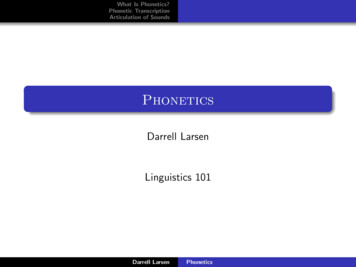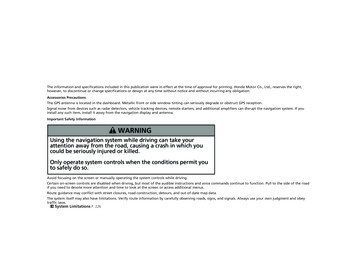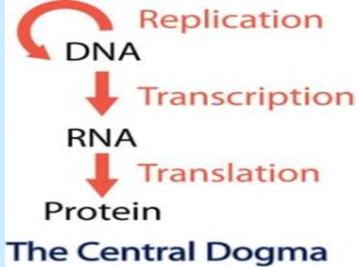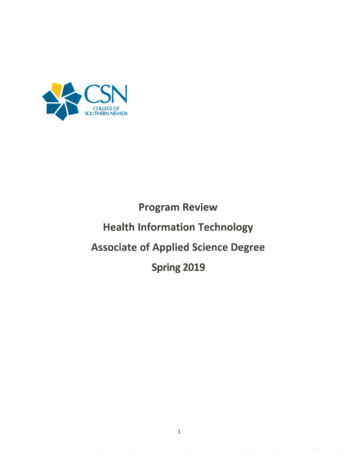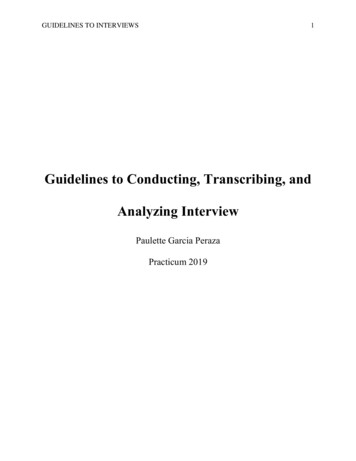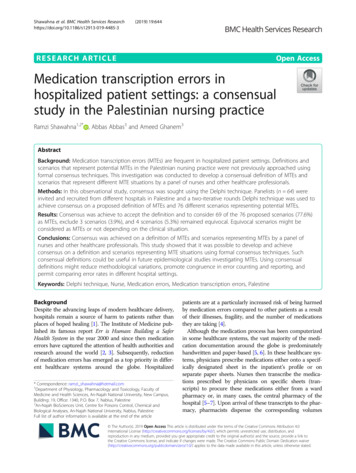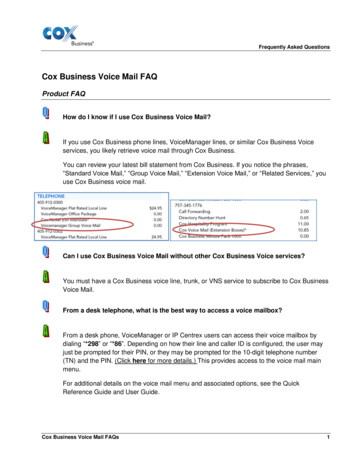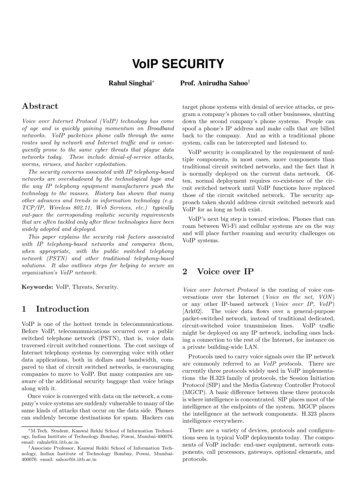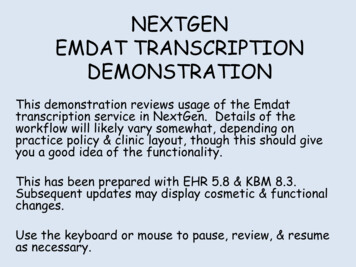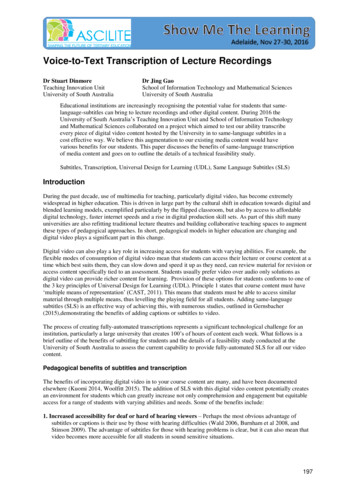
Transcription
Voice-to-Text Transcription of Lecture RecordingsDr Stuart DinmoreTeaching Innovation UnitUniversity of South AustraliaDr Jing GaoSchool of Information Technology and Mathematical SciencesUniversity of South AustraliaEducational institutions are increasingly recognising the potential value for students that samelanguage-subtitles can bring to lecture recordings and other digital content. During 2016 theUniversity of South Australia’s Teaching Innovation Unit and School of Information Technologyand Mathematical Sciences collaborated on a project which aimed to test our ability transcribeevery piece of digital video content hosted by the University in to same-language subtitles in acost effective way. We believe this augmentation to our existing media content would havevarious benefits for our students. This paper discusses the benefits of same-language transcriptionof media content and goes on to outline the details of a technical feasibility study.Subtitles, Transcription, Universal Design for Learning (UDL), Same Language Subtitles (SLS)IntroductionDuring the past decade, use of multimedia for teaching, particularly digital video, has become extremelywidespread in higher education. This is driven in large part by the cultural shift in education towards digital andblended learning models, exemplified particularly by the flipped classroom, but also by access to affordabledigital technology, faster internet speeds and a rise in digital production skill sets. As part of this shift manyuniversities are also refitting traditional lecture theatres and building collaborative teaching spaces to augmentthese types of pedagogical approaches. In short, pedagogical models in higher education are changing anddigital video plays a significant part in this change.Digital video can also play a key role in increasing access for students with varying abilities. For example, theflexible modes of consumption of digital video mean that students can access their lecture or course content at atime which best suits them, they can slow down and speed it up as they need, can review material for revision oraccess content specifically tied to an assessment. Students usually prefer video over audio only solutions asdigital video can provide richer content for learning. Provision of these options for students conforms to one ofthe 3 key principles of Universal Design for Learning (UDL). Principle 1 states that course content must have‘multiple means of representation’ (CAST, 2011). This means that students must be able to access similarmaterial through multiple means, thus levelling the playing field for all students. Adding same-languagesubtitles (SLS) is an effective way of achieving this, with numerous studies, outlined in Gernsbacher(2015),demonstrating the benefits of adding captions or subtitles to video.The process of creating fully-automated transcriptions represents a significant technological challenge for aninstitution, particularly a large university that creates 100’s of hours of content each week. What follows is abrief outline of the benefits of subtitling for students and the details of a feasibility study conducted at theUniversity of South Australia to assess the current capability to provide fully-automated SLS for all our videocontent.Pedagogical benefits of subtitles and transcriptionThe benefits of incorporating digital video in to your course content are many, and have been documentedelsewhere (Kuomi 2014, Woolfitt 2015). The addition of SLS with this digital video content potentially createsan environment for students which can greatly increase not only comprehension and engagement but equitableaccess for a range of students with varying abilities and needs. Some of the benefits include:1. Increased accessibility for deaf or hard of hearing viewers – Perhaps the most obvious advantage ofsubtitles or captions is their use by those with hearing difficulties (Wald 2006, Burnham et al 2008, andStinson 2009). The advantage of subtitles for those with hearing problems is clear, but it can also mean thatvideo becomes more accessible for all students in sound sensitive situations.197
2. Improves comprehension for all students – SLS can have a powerful impact on comprehension for allstudents, Steinfeld (1998), Kothari (2008), Brasel and Gips (2014). Providing this kind of access for studentsis an excellent example of UDL principle 1 (Provide multiple means of representation): it can enable thecurriculum for all students, not just those with disabilities. ‘Multiple studies have shown that the sameoptions that allow students with physical and sensory disabilities to access materials, specifically captioningand video description, also provide educational benefits for students with other disabilities, English languagelearners, and general education students.’ (Sapp, 2009, p. 496)3. Translation into foreign languages – As higher education becomes increasingly globalised with manycourses available internationally the need to provide means of comprehension for students from a variety oflanguage backgrounds is crucial (Kruger, Hefer & Matthew 2014). For example, 25% of the University ofSouth Australia’s internal cohort are international students and the ability for those students to easilytranslate course content in to various languages can aid comprehension.4. Enhances foreign language Learning – Multiple studies, such as Zanón (2005), Etamadi (2012),Vanderplank (2013), and Mohsen (2015) have outlined the effectiveness of SLS for students learning a newlanguage. This is because they influence factors like pronunciation, context, speed, reading skill,understanding colloquialisms and aid with rapid word recognition.There are other positive aspects of SLS which may apply to the general student cohort. For example, this moreflexible style of delivery aid to personalised learning – students are able work at their own pace and blend thetime and place of their learning. Subtitles and transcripts can also help make content searchable, so students canlocate the relevant information among an enormous amount of material.Outline of Research Project – Design and MethodologyIn order to test our capability to create fully-automated subtitles for all our digital video content we conducted afeasibility study. We used an automated process to transcribe sample videos housed on our dedicated mediaserver. What we aimed to test was the accuracy vs. cost of using automated voice-to-text generators, given that avery high level of accuracy is essential in higher education due to the use of technical and discipline specificlanguage. A number of experiments were designed to answer the following research question: Can automatedspeech-recognition provide acceptable results for lecture recordings?In total, 30 recordings from the university media library were used, ranging from 2 minutes (a short welcomemessage) to 2 hours (a standard university lecture). Four key areas were considered during data collection:1.2.3.4.Discipline area: covering IT, law, management, engineering and health science.Single voice vs multiple voices: Covering sole speaker and multiple speakers (seminars and workshops).English speakers from different native language background: covering British, Chinese and Indian.With and without background noise: Covering recordings from the lecture theatres, individual offices andclassrooms.Three engines were utilised to perform speech recognition on sample videos (used with default settings, notraining required).1. Google Speech-to-Text: Industry leading, available as beta-testing to selected users only.2. IBM Bluemix Speech-to-Text: Industry leading, available commercially to the public (enhanced and cloudversion or Dragon Naturally Speaking).3. CMUSphinx: leading open source solution, developed at Carnegie Mellon, free to the public.Unlike CMUSphinx (an offline solution), both Google and IBM engines are cloud-based and require audio datato be sent as chunks (e.g. 60 seconds per chunk). This project has also considered the potential recognitionresults differences between short and large chunks (large chunks contain more context so the accuracy ispotentially improved).Due to a very high volume of recordings (approximately 250,000 hours recording per annum at the authors’university) and the varying background of lecturers there are other requirements, outlined below, when adoptinga speech-recognition system and preparing the audio for transcription:1. Speaker-independent: It is time-consuming and nearly impossible to create training voice data sets forindividual speakers. Although the training model of the Dragon Naturally Speaking software can be exportedand re-used on a different machine, due to the recording hardware (different microphones) and backgroundnoise, the applicability of the training model significantly degrades.2. Context-specific: University lectures often have discipline-specific terminologies. The speech-recognitionengine should be capable of identifying terminology based on the content discipline.3. Big Data friendly: University recordings are managed by a central server. In a large scale deployment (totake a large volume of recordings), recognition cannot be done on individual lecturer’s computers, a fullyautomated server environment is essential.198
4. Usable results: In addition to the expected level of accuracy, the results need to be provided to the end-users(both staff and students) in a way that makes viewing recordings more effective and efficient.5. Minimum human intervention: Human transcribing and editing is expensive and time-consuming.Further to the considerations outlined above, a typical speech recognition process includes four elements:1. Core engine: Process the input audio files and match the dictionary words base on the statistical modelsspecified in the language model and acoustic model;2. Pronouncing Dictionary: It can map from words to their pronunciations (e.g. en-US, in the ARPAbetphoneme set, a standard for English pronunciation).3. Language model: A simple one may contain a small set of keywords (e.g. used in automated phoneanswering machine) and the grammar of the language. The other variant, statistical language models,describe more complex language. They contain probabilities of the words and word combinations. Thoseprobabilities are estimated from a sample data; and4. Acoustic model: This is a statistical model as a result of a large set of training data which are carefullyoptimised to achieve best recognition performance (e.g. adapter to a certain accent and recordingenvironment).In addition to these core components, there are other components which are designed to further improverecognition accuracy. For example, speaker dependent speech recognition software (e.g. Dragon NaturallySpeaker) includes a software component to build the acoustic model from the speaker’s voice (which is oftenreferred as the ‘training’ process). Many cloud-based engines will use the recognised keywords to search for thepossible context. Once the context is identified, a more relevant language model will be used instead of thegeneric one. Additionally, advanced engines such as Google speech-to-text API have built-in predictionalgorithms (searching the database for similar results base on the recognised keywords). Taking in toconsideration this wide range of factors and variables the researchers were confident of comprehensive andnuanced results in response to the research question.Feasibility Study ResultsIn terms of the way the results are expressed it is worth noting the difference between user perceived accuracyand the machine confidence indicators. Both Google and IBM engines provide a confidence indicator (1 as thehighest value) for the recognition results. The researchers read the text scripts while listening to the originalaudio for personal judgement. It was noted that over 30 recordings, the average accuracy confidence exceeded0.70 (the highest one being 0.981). By listening to the audio, it can be determined that the machine confidenceindicators are an underestimation of overall accuracy. The actual level of accuracy is significantly higher. Forexample:[TRANSCRIPT] seek out an activity or resource scroll to the bottom of the page andclick the URL [resource] please add into the name of the URL resource and descriptionopen the video confirmation email highlight the link right click and copy the link closethe email scroll down and paste the link into the external URL field. [confidence:0.8921][TRANSCRIPT] scroll to the bottom of the page and click save and return to courseclick the video resource link and hit the video. [confidence: 0.9311]The above two transcripts actually matched every single word in the original audio, yet the confidenceindicators do not reach 1. This finding is consistent across all sample data. Generally speaking, user perceivedaccuracy is higher than the machine generated confidence indicators.Another area of difficulty from the transcribed results relates to the issue of readability. The transcripts mayhave a relatively high level of word recognition accuracy but their readability is low. For example:[TRANSCRIPT] if I wish to use the Today Show two of you to manage an appointment so I canclick through on appointment time and that I showed you here I get a summary of allappointments for a particular guy I can talk with you today by using the left and right arrow orusing the calendar drop down I can arrange to buy stuff. [confidence: 0.7954][TRANSCRIPT] information about who the appointments with and if this unit but did you seehere that older white coloured Apartments off of Mormons and the purple coloured appointmentsare booked appointments if I have the mass of it as appointments so I can get more details aboutthe petition appointment down the bottom here we have a link for college and our country thatgives a summary of all the symbols. [confidence: 0.7577]199
The above two scripts represent the general accuracy level. Although it is possible to read through the scripts bythemselves, it does not provide a pleasant reading experience for various reasons:1. Lack of punctuation: Nearly all recognition engines skip punctuations if the speaker does not explicitlyspecify (e.g. say “Full Stop”). It seems that the Google and IBM engines will occasionally put one or twowhile still missing the majority. During the lectures, it is simply not practical for lecturers to say thepunctuations. Without full stops, the scripts become difficult to read.2. Lack of grammar: During speaking, speakers tend to focus less on grammar and the completeness ofsentences. There is also tendency for speakers to repeat words that they think are important. However, whilereading, without grammar and sentence structures, the reading experience is further reduced.3. Missing words: Different speech recognition engines have different ways of dealing with mismatches or acomplete miss. The Google engine seems to ignore the words if the quality of match is low. On the otherhand, the IBM engine always tries to give some results even if it is not entirely accurate (as underlinedbelow). Unfortunately, neither approach makes reading any easier. For example:[Google] recording is protected by copyright know. Maybe we producedwithout the prior permission of the University of South Australia. free movinginto the final of the course which is all that digital communication is going tobe looking at pricing for websites like designing and driving traffic to websitewas going to be looking at social media in the next few weeks sorry I'm sureyou're very familiar with social media.[IBM] This recording is protected by copyright no part may be reproducedwithout the prior permission at the university of South Australia. I'm. Your.Hello everyone welcome. I have to excuse me tonight if I sound a bit nicelyup quite a bit of a shocker called happening side has taken it's a bad bad I'myeah obviously just if I sound a bit strange that's why tonight so you'll have toexcuse me for that. So this week we.From the above examples, both sourced from the same recording it is evident that currently, fully automatedspeech recognition, is not able to provide readable scripts from lecture recordings without extensive manualediting.Subtitle creationOne the key aims of this feasibility study was to determine whether acceptably accurate subtitles could beautomatically generated. Although it is possible to read the scripts while listening to the audio (or watching thevideos) we concluded that this function is not feasible (without manual editing) for the following reasons:1. Timestamp is not accurate: In order to link the scripts to actual play time, the audio has to be processed insmall chunks – e.g. 5 seconds. Although it is technically possible to cut the audio into 5 seconds chunks, it isnot possible to ensure that the speaking words are not chopped (e.g. start speaking at 4.9 seconds and finishspeaking at 5.1 seconds). The smaller the chunks are, the more likely this will happen. As a result, therecognition result will be reduced. When cutting the audio in to tiny chunks, it appears that the recognitionengines are not able to identify meaningful context from several words thus reducing the quality ofrecognition.2. Silence detection: It is possible to cut the audio base on the pauses of speaking. This approach will not beable to guarantee consistent audio duration for each cut thus making the timestamp extremely complicated.3. Missing words or mismatching words: Some audio chunks may not yield any results. For example, thefollowing result below actually missed two sentences (that’s also the reason why the confidence indicator isrelatively low).[TRANSCRIPT] yeah I mean it's not the place to come and I'm happy to talk to you afterwardsabout it but I'll let you know around 6 I should go to professional internship. [confidence: 0.6304]Results in relation to key research areas1. Discipline area: Google and IBM engines perform very well in identifying specific words from differentdomains. For example:[TRANSCRIPT] products with heterosexual that that this culture of metrosexualality and they'remore willing to be in the sea are submissive places such as exhausted as the epitome ofmetrosexuality the fall of David Beckham in the top shelf there but we do have the same maybeyou changes in masculinity and in this regard let me to skip across a few here and there is changein relationships have to their bodies you actually changes.200
[TRANSCRIPT] the old racism and whether you're right since it was erasing some of those I'mon my way to find racism in the consequences of that and use the case study of asylum-seekers isa case to think about racism but also to think about what might be a sociological approach tostudying a highly controversial contested issue like this sociology as we talked about is collectingempirical information contrasting that testing social theories developing social theories but it'salso you know I can't do it is.2. Single voice vs multiple voices: The recognition results from single speakers are generally acceptable.However, it is not in the case in workshops where students will ask questions. The major issue is that theaudiences are too far from the recording device thus not able to provide quality audio for recognition. Forexample, a 3 minute group discussion only produced the following results.[TRANSCRIPT] Belkin netcam out why do you want to share something about yourself.[TRANSCRIPT] emoticons greetings examples.[TRANSCRIPT] yeah, yeah, yeah, yeah.3. English speakers from different native language background: Despite the speakers’ background, theoverall results are generally acceptable. However, for native English speakers who speak slowly and clearly,the recognition results are much better. For example, the example below almost had 100% accuracy.[TRANSCRIPT] seek out an activity or resource scroll to the bottom of the page and click theURL resource please add into the name of the URL resource and description open the videoconfirmation email highlight the link right click and copy the link close the email scroll down andpaste the link into the external URL field.4. With and without background noise: IBM and Google engines come with noise cancellation techniques.These techniques worked well for background music, but were less ideal for background human voices. Forexample, the example below wasn’t effected by the loud background music.[TRANSCRIPT] become dishonest as adults lying to customers colleagues and even theirPartners but all is not lost for the next 4 weeks I will be your lead educator guiding you through anexploration of several important questions such as what is academic Integrity why is it soimportant in Academia and how can you as a student at University but she with Integrity in thiscourse will explore the answer to these and other questions each week.Commercial vs Open SourceOpen source engine CMUSphinx is able to produce some results, but not on par with Google and IBM, whichboth generated similar results exceeding researchers’ expectations.IBM: This recording is protected by copyright no part may be reproduced without theprior permission at the university of South Australia.Google: This recording is protected by copyright know. Maybe we produced withoutthe prior permission of the University of South Australia.CMUSphinx: this record is protected by copyright know what may be reproducedwithout our permission could the university.ConclusionFor the creation of fully-automated, highly accurate subtitles in digital video it is recommended that a highquality audio recording is sourced, those related to podcasts rather than recorded lectures. The shorter averagelength of these types of recording mean manual editing would be more efficient. The level of accuracy currentlyavailable, however, is high enough to provide meaningful results for text analytics or topic modelling purposesand this is the direction in which this research now progresses. This is a potentially fruitful area of research anda function which may provide many benefits for students, though not to the extent that would fully supportstudents in the ways mentioned above. After completing this feasibility study we concluded that, currently, noneof the 3 transcription engines used are able to reach an acceptable level of accuracy for subtitle creation, withoutcostly and time consuming human intervention. Given the amount of content produced by a university the levelof manual editing would be far too costly to be of practical use.201
ReferencesBrasel, S. A., & Gips, J. (2014). Enhancing television advertising: same-language subtitles can improve brandrecall, verbal memory, and behavioral intent. Journal of the Academy of Marketing Science, 42(3), 322-336.Burnham, D., Leigh, G., Noble, W., Jones, C., Tyler, M., Grebennikov, L., & Varley, A. (2008). Parameters intelevision captioning for deaf and hard-of-hearing adults: Effects of caption rate versus text reduction oncomprehension. Journal of deaf studies and deaf education, 13(3), 391-404.CAST. (2011). Universal Design for Learning Guidelines Version 2.0. Wakefield MA.Etemadi, A. (2012). Effects of bimodal subtitling of English movies on content comprehension and vocabularyrecognition. International journal of English linguistics, 2(1), 239.Gernsbacher, M. A. (2015). Video Captions Benefit Everyone. Policy Insights from the Behavioral and BrainSciences, 2(1), 195-202.Janfaza, A., Jelyani, S. J., & Soori, A. (2014). Impacts of Captioned Movies on Listening Comprehension.International Journal of Education & Literacy Studies, 2(2), 80.Kothari, B. (2008). Let a billion readers bloom: Same language subtitling (SLS) on television for mass literacy.International review of education, 54(5-6), 773-780.Koumi, J. (2014). Potent Pedagogic Roles for Video. Media and learning association.Kruger, J.-L., Hefer, E., & Matthew, G. (2014). Attention distribution and cognitive load in a subtitled academiclecture: L1 vs. L2. Journal of Eye Movement Research, 7(5).Mohsen, M. A. (2015). The use of help options in multimedia listening environments to aid language learning: areview. British Journal of Educational Technology.Sapp, W. (2009). Universal Design: Online Educational Media for Students with Disabilities. Journal of VisualImpairment & Blindness, 103(8), 495-500.Steinfeld, A. (1998). The Benefit of Real-Time Captioning in a Mainstream Classroom as Measured byWorking Memory. Volta review, 100(1), 29-44.Stinson, M. S., Elliot, L. B., Kelly, R. R., & Liu, Y. (2009). Deaf and hard-of-hearing students' memory oflectures with speech-to-text and interpreting/note taking services. The Journal of Special Education, 43(1),52-64.Vanderplank, R. (2016). ‘Effects of’ and ‘effects with’ captions: How exactly does watching a TV programmewith same-language subtitles make a difference to language learners? Language Teaching, 49(02), 235-250.doi: doi:10.1017/S0261444813000207Wald, M. (2006). Creating accessible educational multimedia through editing automatic speech recognitioncaptioning in real time. Interactive Technology and Smart Education, 3(2), 131-141.Woolfitt, Z. (2015). The effective use of video in higher education: The Hague. Retrieved from https://www.inholland. -education-woolfitt-october-2015. pdf.Zanón, N. T. (2006). Using subtitles to enhance foreign language learning. Porta Linguarum: revistainternacional de didáctica de las lenguas extranjeras(6), 4.Please cite as: Dinmore, S. & Gao, J. (2016). Voice-to-Text Transcription of Lecture Recordings. InS. Barker, S. Dawson, A. Pardo, & C. Colvin (Eds.), Show Me The Learning. Proceedings ASCILITE2016 Adelaide (pp. 197-202).Note: All published papers are refereed, having undergone a double-blind peer-review process.The author(s) assign a Creative Commons by attribution licence enabling othersto distribute, remix, tweak, and build upon their work, even commercially, aslong as credit is given to the author(s) for the original creation.202
199 4. Usable results: In addition to the expected level of accuracy, the results need to be provided to the end-users (both staff and students) in a way that makes viewing recordings more effective and efficient. 5. Minimum human intervention: Human transcribing and editing is expensive and time-consuming. Further to the considerations outlined above, a typical speech recognition process .
